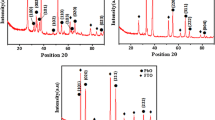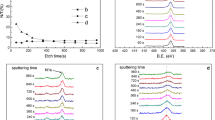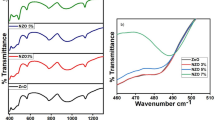Abstract
The present work reports the successful growth and hence, the characterization of Ni:ZnO thin films with varying Ni contents in precursor solution (\(x_{Ni}\) = 0.0, 0.10, 1.00, 4.84, 9.25 and 13.27 \(at.\%\)). The thin films were fabricated on soda lime glass substrate. An indigenously designed and developed aerosol-assisted chemical vapor deposition (AACVD) system has been used for the deposition of Ni:ZnO thin film. Zinc acetylacetonate and Nickel acetylacetonate were used as a source material for Zn and Ni, respectively. To prepare liquid precursor, isopropyl alcohol was used as a solvent for zinc acetylacetonate and Nickel acetylacetonate. The deposition was carried out at a constant growth temperature of 500 \(^o\)C with oxygen as a carrier gas for the precursor. Raman spectroscopy, XRD and UV–visible spectroscopy characterizations were performed to investigate the effect of varying \(x_{Ni}\) content over the optical as well as the structural properties of Ni:ZnO thin films. The average transmittance of undoped and Ni-doped ZnO came out to be about \(\ge\) 95%. The calculated thickness of Ni:ZnO was found to be of the order of hundreds of nanometre i.e., the thin films of sub-micron-sized thickness have been fabricated. The measured bandgaps of Ni:ZnO thin film were found to decrease (red shift) with increasing Ni content in precursor solution. The AACVD-grown Ni:ZnO thin films was found to have low-average absorbance approximately 1% and average reflectance approximately 4%. The XRD characteristic spectra of Ni:ZnO thin films reveal that the required phase is present with a little amount of impurities that matches well with the JCPDS data indicating the hexagonal structure. The particle sizes measured by the XRD Scherer’s formula, values of lattice constants and the volume of unit cell of Ni:ZnO were found to be in a good agreement with literature. Raman spectra of pure and Ni-doped ZnO thin films have been measured at room temperature in the wave number range 150–1300 cm\(^{-1}\). A\(_1\)(TO) modes are obtained in the range of 382–384 cm\(^{-1}\). While, the modes obtained in the ranges 569–572 cm\(^{-1}\) and 1098–1104 cm\(^{-1}\) are allocated as A\(_1\)(LO) and A\(_1\)(2LO) modes respectively.







Similar content being viewed by others
Data availability
The raw/processed data required to reproduce these findings cannot be shared at this time as the data also forms part of an ongoing study.
References
Y. Liu, Y. Li, H. Zeng, ZnO-based transparent conductive thin films: Doping, performance, and processing. J. Nanomater. 2013, 1–9 (2013). https://doi.org/10.1155/2013/196521
J. Fang, Y. Xuan, Investigation of optical absorption and photothermal conversion characteristics of binary CuO/ZnO nanofluids. RSC Advanc. 7(88), 56023–56033 (2017). https://doi.org/10.1039/c7ra12022b
C.-Y. Wu, L.-C. Chiu, J.-Y. Juang, High haze Ga and Zr co-doped zinc oxide transparent electrodes for photovoltaic applications. J. Alloys Compounds 901, 163678 (2022). https://doi.org/10.1016/j.jallcom.2022.163678
R. Liu, Y. Chen, S. Ding, Y. Li, Y. Tian, Preparation of highly transparent conductive aluminum-doped zinc oxide thin films using a low-temperature aqueous solution process for thin-film solar cells applications. Solar Energy Mater. Solar Cells 203, 110161 (2019). https://doi.org/10.1016/j.solmat.2019.110161
S.D. Ponja, S. Sathasivam, I.P. Parkin, C.J. Carmalt, Highly conductive and transparent gallium doped zinc oxide thin films via chemical vapor deposition. Scientific (2020). https://doi.org/10.1038/s41598-020-57532-7
G. Biasotto, M.G.A. Ranieri, C.R. Foschini, A.Z. Simões, E. Longo, M.A. Zaghete, Gas sensor applications of zinc oxide thin film grown by the polymeric precursor method. Ceramics (2014). https://doi.org/10.1016/j.ceramint.2014.06.099
A. Eshaghi, A. Graeli, M. Hajkarimi, Fabrication of transparent conductive aluminum zinc oxide nanostructured thin film on polycarbonate substrate for heat mirror applications. Journal of Optical Technology. 82(1), 51 (2015).
K. Jeyasubramanian, Rv. William, P. Thiruramanathan, G.S. Hikku, M. Vimal Kumar, B. Ashima, P. Veluswamy, H. Ikeda, Dielectric and magnetic properties of nanoporous nickel doped zinc oxide for spintronic applications. J. Magnet. Magnet. Mater. 485, 27–35 (2019). https://doi.org/10.1016/j.jmmm.2019.04.032
A. Samanta, M.N. Goswami, P.K. Mahapatra, Magnetic and electric properties of Ni-doped ZnO nanoparticles exhibit diluted magnetic semiconductor in nature. J. Alloys Compounds 730, 399–407 (2018). https://doi.org/10.1016/j.jallcom.2017.09.334
S. Sánchez-Martín et al., Study of deposition parameters and growth kinetics of ZnO deposited by aerosol assisted chemical vapor deposition. RSC Advanc. 11(30), 18493–18499 (2021). https://doi.org/10.1039/d1ra03251h
D. Viet Vu, D. Hai Le, C. Xuan Nguyen, T. Quang Trinh, Comparison of structural and electric properties of ZnO-based N-type thin films with different dopants for thermoelectric applications. J. Sol-Gel Sci. Technol. 91(1), 146–153 (2019). https://doi.org/10.1007/s10971-019-05024-0
A. Jiamprasertboon et al., Low-cost one-step fabrication of highly conductive ZnO: Cl transparent thin films with tunable photocatalytic properties via aerosol-assisted chemical vapor deposition. ACS Appl. Electron. Mater. 1(8), 1408–1417 (2019). https://doi.org/10.1021/acsaelm.9b00190
Z. Manzoor, et al. (2020) “Optical and structural properties of nickel doped zinc oxide grown by metal organic chemical vapor deposition (MOCVD) at different reaction chamber condition.” ES Materials & Manufacturing [Preprint]. 10.30919/esmm5f715
Ö. Çelik, Ş Baturay, Y.S. Ocak, Sb doping influence on structural properties of ZnO thin films. Mater. Res. Exp. 7(2), 026403 (2020). https://doi.org/10.1088/2053-1591/ab6c8a
J. Mathew, G. Varghese, J. Mathew. 2014 “Structural and optical properties of Ni:ZnO thin films-effect of annealing and doping concentration.” SOP Transactions on Applied Physics. 10.15764/aphy.2014.04003
C.C. Diao, C.Y. Huang, C.F. Yang, C.C. Wu, Morphological, optical, and electrical properties of P-type nickel oxide thin films by nonvacuum deposition. Nanomaterials 10(4), 636 (2020). https://doi.org/10.3390/nano10040636
D.B. Potter et al., Al-, Ga-, and In-doped ZnO thin films via aerosol assisted CVD for use as transparent conducting oxides. Phys. Status Solidi. 213(5), 1346–1352 (2016)
J.A. Spencer, A.L. Mock, A.G. Jacobs, M. Schubert, Y. Zhang, M.J. Tadjer, A review of band structure and material properties of transparent conducting and semiconducting oxides: Ga\(_{2}\)O\(_{3}\), Al\(_{2}\)O\(_{3}\), In\(_{2}\)O\(_{3}\), ZnO, SnO\(_{2}\), CdO, NiO, CuO, and Sc\(_{2}\)O\(_{3}\). Appl. Phys. Rev. 9(1), 011315 (2022). https://doi.org/10.1063/5.0078037
A. de Andres, F. Jimenez-Villacorta, C. Prieto, The compromise between conductivity and transparency. Trans. Conduct. Mater. (2018). https://doi.org/10.1002/9783527804603.ch1
Sani Garba Danjumma, Nickel oxide (NiO) devices and applications: a review. Int. J. Eng. Res. (2019). https://doi.org/10.17577/ijertv8is040281
I. Elhamdi, H. Souissi, O. Taktak, J. Elghoul, S. Kammoun, E. Dhahri, B.F. Costa, Experimental and Modeling Study of ZnO: Ni nanoparticles for near-infrared light emitting diodes. RSC Advanc. 12(21), 13074–13086 (2022). https://doi.org/10.1039/d2ra00452f
M.Y. Ali, M.K.R. Khan, A.T. Karim, M.M. Rahman, M. Kamruzzaman, Effect of Ni doping on structure, morphology and opto-transport properties of spray pyrolised ZnO nano-fiber. Heliyon (2020). https://doi.org/10.1016/j.heliyon.2020.e03588
T.V.K. Karthik, M.D.L.L. Olvera, A. Maldonado, R.R. Biswal, H. Gómez-Pozos, Undoped and nickel-doped zinc oxide thin films deposited by DIP coating and ultrasonic spray pyrolysis methods for propane and carbon monoxide sensing applications. Sensors 20(23), 6879 (2020). https://doi.org/10.3390/s20236879
O. Bayram, E. Sener, E. İgman, O. Simsek, Investigation of structural, morphological and optical properties of nickel-doped zinc oxide thin films fabricated by co-sputtering. J. Mater. Sci. Mater. Electron. 30(4), 3452–3458 (2019). https://doi.org/10.1007/s10854-018-00620-2
T. Wakano, N. Fujimura, Y. Morinaga, N. Abe, A. Ashida, T. Ito, Magnetic and Magneto-transport properties of ZnO: Ni films. Phys. E Low-Dimension. Syst. Nanostruct. 10(1–3), 260–264 (2001). https://doi.org/10.1016/s1386-9477(01)00095-9
K.S. Kazunori Sato, H.K.-Y. Hiroshi Katayama-Yoshida, Material design for transparent ferromagnets with ZnO-based magnetic semiconductors. Japanese Journal of Applied Physics. (2000). https://doi.org/10.1143/jjap.39.l555
S.B. Rana, R.P. Singh, Investigation of structural, optical, magnetic properties and antibacterial activity of Ni-doped zinc oxide nanoparticles. J. Mater. Sci. Mater. Electron. 27(9), 9346–9355 (2016)
R. Siddheswaran, M. Netrvalová, J. Savková, P. Novák, J. Očenášek, P. Šutta, R. Jayavel, Reactive magnetron sputtering of Ni doped ZnO thin film: Investigation of Optical, structural, mechanical and magnetic properties. J. Alloys Compounds 636, 85–92 (2015). https://doi.org/10.1016/j.jallcom.2015.02.142
A.K. Rana, Y. Kumar, P. Rajput, S.N. Jha, D. Bhattacharyya, P.M. Shirage, Search for origin of room temperature ferromagnetism properties in Ni-doped ZnO nanostructure. ACS Appl. Mater. Interf. 9(8), 7691–7700 (2017). https://doi.org/10.1021/acsami.6b12616
M. Koyano, P. QuocBao, L.T. ThanhBinh, L. HongHa, N. NgocLong, S.I. Katayama, Photoluminescence and Raman spectra of ZnO thin films by charged liquid cluster beam technique. Phys. Status Solidi. 193(1), 125–131 (2002)
P. Kaim, K. Lukaszkowicz, M. Szindler, M. M. Szindler, M. Basiaga, B. Hajduk, The influence of magnetron sputtering process temperature on ZnO thin-film properties. Coatings 11(12), 1507 (2021). https://doi.org/10.3390/coatings11121507
Acknowledgements
The authors acknowledge Dr. J.T. Andrews of SGSITS Indore, for the constant guidance and support during the course of the work. The authors also thank Dr. Mukul Gupta for XRD characterization at UGC-DAE CSR, Indore.
Funding
The authors declare that no funds, grants, or other support was received during the preparation of this manuscript.
Author information
Authors and Affiliations
Contributions
All authors contributed to the study conception and design. Material preparation, data collection and analysis were performed by Krutika Natu and Vipin K. Kaushik. The first draft of the manuscript was written by Vipin K. Kaushik, and Meena Laad and all authors commented on previous versions of the manuscript. All authors read and approved the final manuscript.
Corresponding author
Ethics declarations
Conflict of interest
The authors have no relevant financial or non-financial interests to disclose.
Additional information
Publisher's Note
Springer Nature remains neutral with regard to jurisdictional claims in published maps and institutional affiliations.
Rights and permissions
Springer Nature or its licensor (e.g. a society or other partner) holds exclusive rights to this article under a publishing agreement with the author(s) or other rightsholder(s); author self-archiving of the accepted manuscript version of this article is solely governed by the terms of such publishing agreement and applicable law.
About this article
Cite this article
Natu, K., Kaushik, V.K. & Laad, M. Optical and structural characterization of aerosol-assisted CVD-grown Ni:ZnO thin films. J. Korean Phys. Soc. 83, 200–208 (2023). https://doi.org/10.1007/s40042-023-00809-7
Received:
Revised:
Accepted:
Published:
Issue Date:
DOI: https://doi.org/10.1007/s40042-023-00809-7




